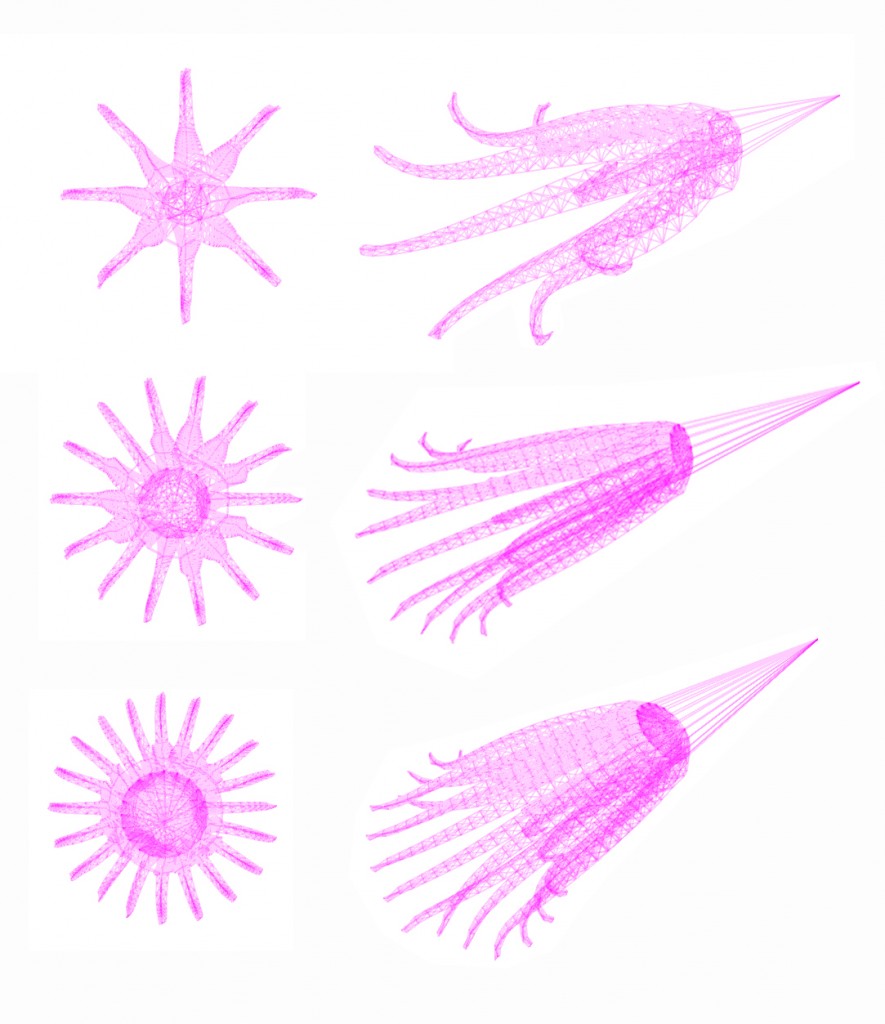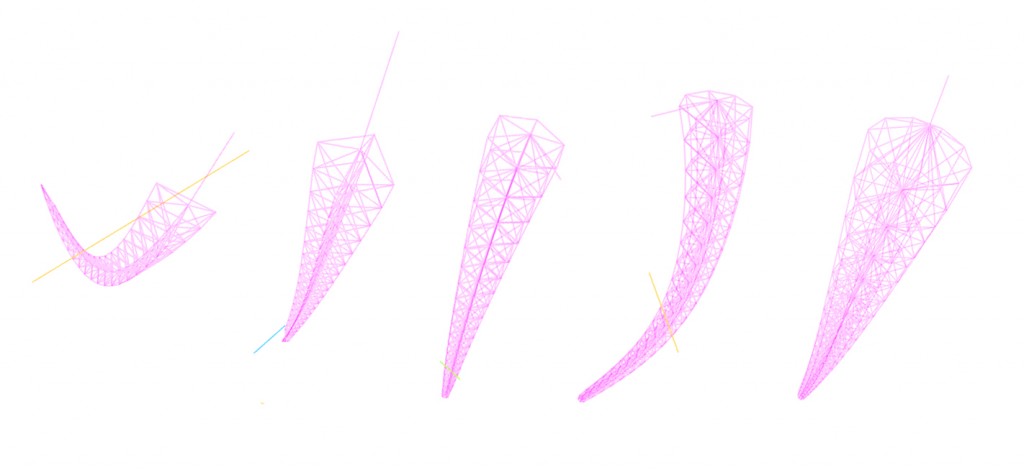Madeline Gannon-Generative Form-Project 3
Generative Form with Verlet Physics and Toxiclibs
___________________________________________________________________________________
___________________________________________________________________________________
___________________________________________________________________________________
[vimeo https://vimeo.com/37585051 w=600&h=450]



————————–
what about your inspiration? you previously mentioned a historical fiction illustrator?
tentacles
–awww snap
video VIDEO! yess … although the black background is not so good, I think a more netural grey would have been better, also assume the contrast will always be bad when presenting …
–the video looks like the tentacles are a little too stuck together. Almost as if the tentacles are “holding their arms” to its side–let them flow more freely.
the still images of the tentacles look very fluid and nice, like tentacles should be.
Very Lovecraftian. It’s mesmerising to watch. How is it generative? Is it just random? Or is the generative aspect that you can fling these tentacles around and freeze them mid-motion and that generates a form that you can print (eventually)? As far as input devices go: a friend of mine in undergrad built an EM sensor (I think that’s what it was) that could detect how close your hand was based on how it distorted the electromagnetic field. With two such sensors at right angles to each other you could probably get a decent 3D image of the hand’s position & orientation. That might be a cool, if vaguely Minority Report, interaction for manipulating these forms in 3D space.
very cool visualization, is it just a generative reaction then? it would be cool to play with more constraints
Lovely! See Cinder Medusae by Marcin Ignac:
http://marcinignac.com/projects/cindermedusae/
I’m interested to hear what realm you think this can exist in. I think most easily it is something to allow kids to play with. Not to say thats a bad thing, but kids are easily impressed. I would be more curious to see the advantages of tentacles in real life for animals and behavior. And if these animal advantages can be reapplied to a more human concept.
this is really cool, since, you have tentacles already, maybe try different ways you can wrap it or curl it around a cylinder or finger. rings are small and cheap so probably easier to prototype with, and I think they’d be so cool with the jelly mesh (if you end up doing this definitely let me know!)
You might like these http://www.ovmlove.com/collections/jewelry/
Maybe have different tools that you can select… growth tools; repulser tools; curler ^^ etc… Other objects that interact with it and cause growth patterns?
The movements look very fluid and realistic, or at least what I imagine an actual cephalopod would do. Are the number and positions of the tentacles generated or where you mainly focused the movement of individual tentacles? Have you considered doing anything with IK constraints so that the tentacles can “reach” to specific points? I know there are some good (2D) examples in the standard Processing examples, that I’ve actually used for tentacle-like things before.
-> http://rhondaforever.com/ for 2d interface for 3d
————————-
Ooh. I like how it spawns. It looks really cool, and the movements are very jelly. The difficulty is that the jellyfish body already implies a specific motion, so the interaction with it may not be necessarily a surprise. So what if you do something completely against the norm?
I think the interesting space here is not necessarily THIS object used as a modeling tool, but your insistence that our modeling environments don’t have to be aproximations of existing tools. What interests me is the question, ‘How does a ‘jellyfish’ model the space around it’, ‘How do we model space LIKE a ‘jellyfish”, ‘What if we could feel space like a ‘jellyfish’, where ‘jellyfish’ means whatever modeling tool we can imagine. PS “tentacly” is now a word.-zack
Looks just like the jelly fish floating around at the aquarium
this would be sweet to interact with on a touchscreen
really natural looking in motion! I think you might want to focus on motion and manipulation more than trying to 3D print them. To me, the motion is REALLY the great part+1agreed
woah!
this tentacle/tentacled creature looks crazy in the black void. the aesthetic is cool and the movement is so natural looking with the flowy-ness of hte arms. looks great!
^ If some other sea creature swam out from the background, I would flip a shit. In a good way!
try giving the animals simple behavior sets, so they self explore shape. if it wanders and pulses you will get the sense of its design.
move beyond the world of 3d modeling into the space of character.
This is a crazy idea, but it might be interesting to 3D print a looping sequence of squid movement — for a stop-frame animation.
Thanks for guiding our feedback. Maybe the mouse is the problem — use a 3d gaming interface? There are lots!
Awesome forms, I can’t wait to see the final printed objects. Might be weird to wear a tentacally calamari around my neck? Personal taste. Where are the particles? I don’t think I understand this fully. For 3D control I’ve seen some people use the Falcon controller : http://www.novint.com/ I’ve heard good things but can’t speak to how effective that would be for your product. Maybe you could just use keyboard controls to drive the squid’s motion? WSAD to drag the body and arrow keys to twist/rotate it. The mouse would still maintain camera control, then. It’s kind of clunky but this has worked for a lot of games in the past.
I love the aesthetics of your project! it’s interactive and beautiful. can’t wait to see the 3D printed out version. (right now your design reminds me of abstract jellyfish)
how about touchOSC. <--I'm imagining pinch to zoom but ti pinching pulses the tentacles. That would be sweet. ------------------------- very pretty- it looks like a very organic and believable creature **indeed the movement seems very oragnic! I am hyponthized by your creature! Wasn't sure what is the random component that it has. ** Yes the motion is beautiful. Mezmerizing. I like your tablet idea for interaction. < yeah it could be cool to see gravity at work on the creature (like turn it on and off) Also for interaction it could depend on how structured a manipulation you'd like I think? Do you want to be able to manipulate each tentacle to have a lot of control over the final product or let it go a more simulative route and let the natural movement of tentacles and go with that aesthetic? It seems hard to translate your visual progress into a physical form, I think you should go farther with the great virtual creature you already have! The tentacle motion is beautiful. It is really beatutiful to see how it moves and floats. However, I really want to the process of making it. What about if you had obstacles in space that would make the tentacles stick at unexpected locations? -------------------------